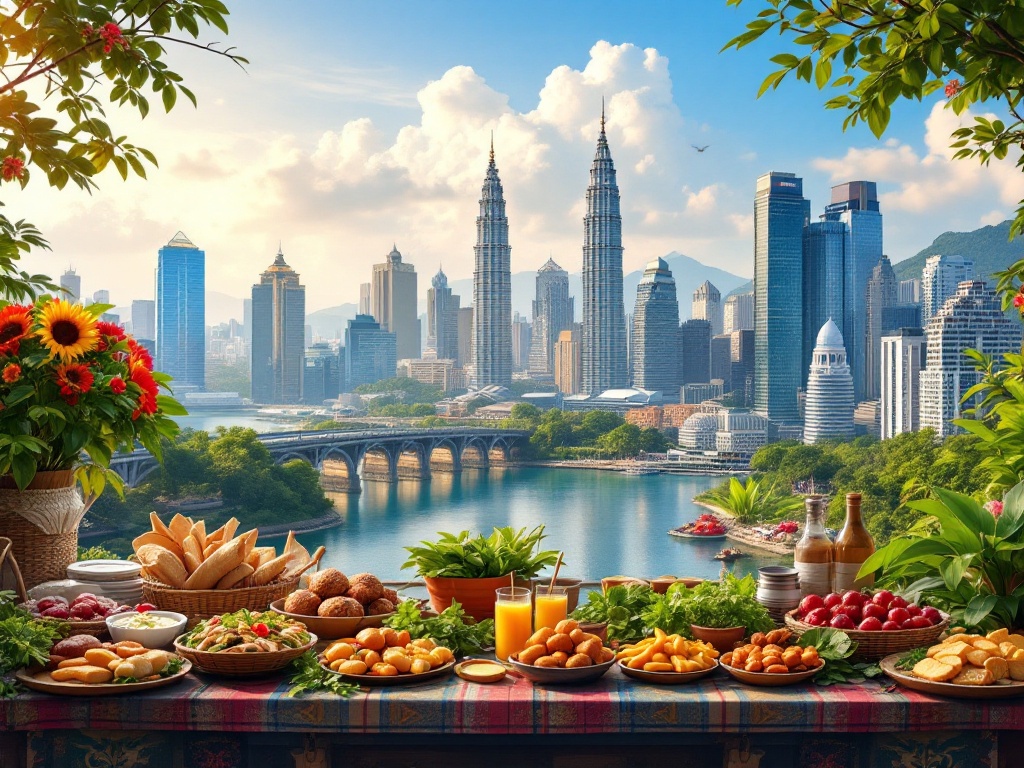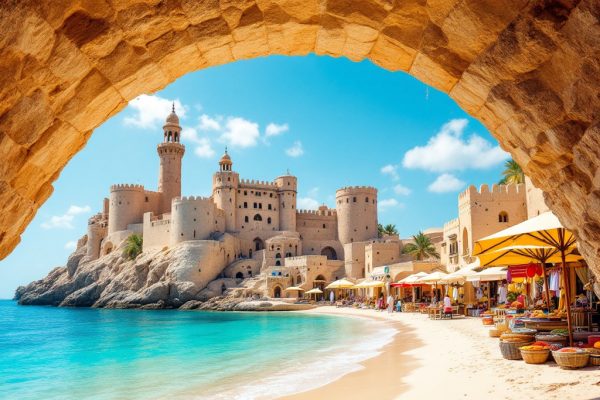Preparing for a Holiday in Malaysia
Dreaming of a Malaysian adventure? Discover the best times to visit Peninsular Malaysia and Borneo (November-August and March-September respectively) for optimal weather. Learn essential travel tips, from visa requirements (including the mandatory MDAC) and health precautions to packing essentials for Malaysia’s tropical climate. Uncover local etiquette, transportation options, staying connected, currency exchange, and culinary delights. Explore vibrant cities like Kuala Lumpur, relax on pristine beaches, and immerse yourself in Borneo’s breathtaking rainforests. Plan your perfect Malaysian getaway now!
Important information

- Malaysia is a tropical country with warm, humid weather year-round (average 30°C/86°F). The best time to visit most of Peninsular Malaysia is November to August, while the best time for Borneo and the east coast is March to September.
- Travelers need a passport valid for at least six months beyond their return date. Many nationalities enjoy visa-free stays, but all travelers must complete the Malaysian Digital Arrival Card (MDAC) online at least three days before arrival.
- Recommended vaccinations include Hepatitis A and B, Typhoid, and Tetanus. It’s advised to pack insect repellent, sunscreen, a basic first-aid kit, and any prescription medications.
- Dress modestly, especially when visiting religious sites. Use your right hand for greetings and eating. Public displays of affection are generally frowned upon.
- The Malaysian currency is the Ringgit (MYR). Credit cards are widely accepted in cities, but cash is preferred in rural areas. ATMs are readily available. Inform your bank of your travel dates to avoid card issues.
Climate and Best Time to Visit Malaysia
Malaysia’s tropical climate offers warm, humid weather year-round, averaging around 86°F (30°C). For the best experience, visit during the drier months, generally November to August, ideal for exploring both Peninsular Malaysia and Borneo. Remember to apply for your Malaysia Digital Arrival Card before your trip.
Best time to visit
While rain is possible anytime, Malaysia’s humidity and consistent temperatures create distinct wet seasons. The west coast experiences more rain from April to October, while the east coast’s wetter period is November to February.
Planning your trip
Planning a trip to Kuala Lumpur or most of Peninsular Malaysia? The best time is between November and August. However, if you’re heading to the east coast or Borneo, aim for the dry season from March to September.
Typical Weather and Temperatures
Malaysia’s tropical climate offers consistently warm temperatures, typically ranging from 21°C to 32°C (70°F to 90°F). Coastal regions enjoy stable warmth, while mountain areas offer a cooler respite. Rainfall occurs throughout the year, varying by location and monsoon season. Some areas experience significantly heavier downpours during specific periods.
Optimal Months for Travel
The best time to explore Kuala Lumpur and Peninsular Malaysia is between November and August, avoiding the monsoon season.
If you’re heading to Borneo or the East Coast, plan your trip from March to September for optimal weather.
Enjoy your Malaysian adventure!
Travel Documents and Visa Requirements
Ensure your passport’s validity extends at least six months beyond your return date. Visa requirements depend on your nationality, with many nationalities enjoying visa-free stays in Malaysia, ranging from two weeks to three months. However, it’s essential to verify your country’s specific visa requirements on the official Malaysian government website. Before arriving in Malaysia, all travelers must complete the Malaysia Digital Arrival Card (MDAC). This electronic travel authorization is mandatory for entry.
Passport Validity and Visa Needs
Planning a trip to Malaysia? Ensure your passport is valid for at least six months after your arrival date. Most nationalities can enjoy a 90-day visa-free stay, but almost everyone needs to complete a Malaysia Digital Arrival Card (MDAC) before entering.
Malaysian Digital Arrival Card (MDAC)
To streamline immigration and expedite entry, travelers to Malaysia must complete the Malaysian Digital Arrival Card (MDAC). The MDAC is a digital form that replaces the previous paper-based arrival and departure cards. It allows travelers to submit their information electronically before arriving in Malaysia. This simplifies the immigration process and reduces waiting times at the airport.
Here’s a step-by-step guide:
Download the app or visit the website. The MDAC can be accessed through the official mobile app or the dedicated website.
Create an account. Register for an account to save your information for future trips.
Fill in your details. Provide accurate personal and travel information, including passport details, flight information, and health declaration.
Submit the form. Submit the completed MDAC at least three days before your arrival in Malaysia.
Receive your QR code. Upon submission, you will receive a QR code as confirmation. Save this QR code on your mobile device or print a copy.
Present the QR code. Present the QR code at the immigration counter upon arrival in Malaysia.
Completing the MDAC prior to arrival ensures a smoother and more efficient immigration process, allowing you to start your Malaysian adventure with ease. You can find more information and apply for the MDAC at the Malaysia Digital Arrival Card website.
Health and Safety Precautions
Stay healthy during your trip to Malaysia by getting vaccinated against Hepatitis A and B, Typhoid, and Tetanus. Don’t drink tap water directly, boil it first or stick to bottled water. Pack any prescription medications and a basic first-aid kit. Protect yourself from mosquito-borne illnesses like Malaria and Dengue fever by using insect repellent and choosing accommodations with mosquito nets.
Vaccinations and Medical Care
Consult your doctor about recommended vaccinations, such as typhoid, hepatitis A, and B, before traveling to ensure your health and safety. Planning is essential, especially for remote trips. Consider obtaining medical evacuation insurance, which covers emergency transport and provides peace of mind in unforeseen situations.
Emergency Contacts and Important Numbers
In Malaysia, dial 999 for any emergency, this connects you to police, fire, and ambulance services. Alternatively, 112 from your mobile phone will also summon medical assistance. U.S. citizens can additionally contact the American Embassy in Kuala Lumpur at +60 3-2168-5000.
Packing Essentials for a Malaysian Holiday
Pack light, breathable clothing such as cotton shirts and shorts, or linen dresses. However, remember modest attire, such as long pants and sleeves, for religious sites. Weather can be unpredictable, so bring a light raincoat or an umbrella for unexpected showers. Comfortable footwear is essential; sneakers or flip-flops are ideal. Don’t forget sun protection: a hat and sunscreen are vital.
For your health and safety:
- a small first-aid kit is handy for minor injuries,
- insect repellent is crucial for preventing mosquito bites,
- consult your doctor about necessary vaccinations.
For your peace of mind:
- travel insurance is highly recommended for unforeseen issues,
- a travel security wallet is a smart way to protect your valuables.
Clothing Tips for the Tropical Climate
Pack light, loose-fitting cotton clothing for your trip, as the year-round average temperature is a comfortable 30°C. Comfortable footwear, such as sneakers or flip-flops, is essential for navigating the area. Although the weather is generally warm, a light jacket can be helpful in air-conditioned spaces. Remember sun protection: pack a hat and sunscreen. Modest dress is recommended, especially when visiting religious sites. Lastly, a light raincoat or umbrella is advisable due to common rain showers.
Health and Safety Items to Pack
Pack prescription medications in their original containers.
Bring a basic first-aid kit containing bandages, antiseptic wipes, and pain relievers.
For rainforests or rural areas, pack insect repellent.
Ensure sun protection with sunscreen, after-sun lotion, and a hat.
Pack a copy of your travel insurance information and emergency contacts.
Understanding Local Etiquette and Dress Code
Respecting Local Customs in MalaysiaWhen visiting Malaysia, dress modestly to respect the country’s diverse culture. Conservative attire is generally recommended for everyone. Women are often encouraged to cover their heads in mosques and temples. Public displays of affection are typically frowned upon.
Greetings and Eating
Use your right hand for greetings and eating, as the left hand is considered unclean.
Pointing
Point with your thumb rather than your index finger.
Maintaining a quiet demeanor is also seen as a sign of respect.
Modesty and Appropriate Attire
When traveling in Malaysia, remember to dress respectfully. Casual attire is generally acceptable in urban areas, but modesty is key when visiting religious sites or rural communities. For women, this means covering their shoulders and knees. A sarong or shawl can easily achieve this. Men should avoid wearing sleeveless shirts. Swimwear should also be modest, especially outside of resort areas. Dressing respectfully shows consideration for local customs and traditions.
Here are some helpful tips for dressing respectfully in Malaysia:
For Women
- Cover your shoulders and knees when visiting religious sites or rural communities.
- Carry a sarong or shawl for easy coverage.
- Choose modest swimwear, particularly outside of resort areas.
For Men
- Avoid sleeveless shirts when visiting religious sites or rural communities.
- Opt for modest swimwear, especially outside of resort areas.
Respecting Cultural Norms
When visiting Malaysia, remember to respect local customs. Use your right hand for greetings, eating, and giving or receiving items, as the left hand is considered unclean. Use your thumb instead of pointing with your index finger. Dress modestly, particularly when visiting religious sites, and avoid public displays of affection. Maintain a respectful volume when speaking in public spaces. Remove your shoes before entering homes and certain businesses. Malaysia’s diverse population includes Malay, Chinese, and Indian communities, each with its own distinct traditions. Be mindful of these cultural differences.
Getting Around Malaysia
Traveling within Malaysia is easy thanks to its diverse transportation network. For intercity travel, the Electric Train Service (ETS) offers a fast and efficient option. Buses provide extensive coverage at affordable prices, servicing numerous routes throughout the country. Ride-hailing services like Grab and taxis are widely accessible for shorter trips within cities. Domestic flights connect major cities across Malaysia, facilitating travel over longer distances. Online booking is available for both bus and train tickets, adding to the convenience. Consider hiring a private driver or joining a guided tour for exploring more remote areas. An International Driving Permit (IDP) is required along with your U.S. driver’s license if you plan to rent a car.
Public Transportation Options
Traveling around Malaysia offers various public transportation options, including buses, trains, taxis, and ridesharing services like Grab. For longer journeys, consider domestic flights or reputable bus companies, but be aware of possible delays. To reach remote areas, hiring a private driver or joining a guided tour can be beneficial. Account for extra travel time due to potential city traffic congestion. An International Driving Permit is recommended if you plan to rent a car.
Using the Grab App and Private Drivers
Grab, similar to Uber, is a popular ridesharing app for journeys of all distances within Malaysia. For trips to remote areas, consider alternatives like private drivers or guided tours.
Staying Connected: Internet and SIM Card Options
Staying connected in Malaysia is easy. Purchase a prepaid SIM card upon arrival at the airport from providers like Celcom, Digi, Maxis, and U Mobile. These SIM cards offer various data packages and validity periods, ideal for navigation, ride-hailing apps, and internet browsing. While international roaming is an option, confirm your plan details with your home provider before traveling.
Purchasing a SIM Card at the Airport
Get your SIM card at any major Malaysian airport and connect to mobile networks immediately after landing.
Network Providers and Internet Access
Planning a trip to Malaysia? Staying connected is easy. Purchase a prepaid SIM card from major providers like Celcom, Digi, Maxis, and U Mobile. These providers offer a range of data plans suitable for travelers. Enjoy excellent 4G and 5G service in most cities and tourist areas. Free Wi-Fi is readily available in cafes, restaurants, and shopping malls.
Currency and Payment Methods
The Malaysian currency is the ringgit (MYR). It comprises banknotes (RM1, RM5, RM10, RM20, RM50, and RM100) and coins (5, 10, 20, and 50 sen). One ringgit is equivalent to 100 sen.
Currency Exchange
Currency exchange is readily available throughout Malaysia at banks, money changers, hotels, and airports. Comparing rates beforehand is advisable to secure the best deal.
Payment Methods
While credit and debit cards are widely accepted, especially in urban areas, carrying ringgit is recommended for smaller purchases and transactions in rural regions. ATMs are plentiful, offering easy cash withdrawals. Remember to check with your bank about potential fees and inform them of your travel dates to avoid any card issues.
Using the Malaysian Ringgit
In Malaysia, the official currency is the Malaysian Ringgit (MYR). While cash is preferred, particularly in rural areas, credit cards are commonly accepted in cities. ATMs are widespread, but it’s wise to notify your bank of your travel dates to avoid any card complications. Exchange or withdraw currency locally for the best rates upon arrival.
Currency Exchange Tips
For the best exchange rates, try banks or authorized money changers. Comparing rates beforehand can save you money, and don’t forget to check for hidden fees.
Informing your bank of your travel plans can prevent card issues.
Airport and hotel exchanges often have less favorable rates, so it’s best to avoid them.
Consider a prepaid travel card for added security and budget management – it’s a wise choice.
Culinary Delights: Eating and Drinking in Malaysia
Experience the diverse flavors of Malaysian street food, a blend of Malay, Chinese, and Indian cuisines. From the fragrant coconut rice of Nasi Lemak to the spicy noodle soup Laksa, your palate will be delighted. Hawker centers offer a wide variety of dishes. For vegetarians and vegans, the HappyCow app helps locate suitable restaurants. Consider a food tour to discover hidden culinary treasures.
While alcohol is available, it is often pricier than in neighboring countries, especially wine and spirits.
Enjoy Malaysia’s refreshing non-alcoholic drinks like fruit teas and smoothies – a delicious and affordable way to savor local flavors.
Exploring Malaysian Street Food
Experience the vibrant and affordable world of Malaysian street food, a delicious reflection of the country’s rich cultural diversity. Discover countless hawker centers and street stalls offering an incredible variety of Malay, Chinese, and Indian cuisine. For the freshest and safest experience, choose vendors popular with locals and select dishes cooked to order. Clearly communicate any dietary restrictions to ensure a delightful and worry-free culinary adventure.
Alcohol Regulations and Local Beverages
Alcohol consumption is generally permitted in Malaysia, but with some exceptions. Certain “dry” areas prohibit the sale and consumption of alcohol. Non-alcoholic beverages are readily available, such as the popular *teh tarik*, a sweet and milky “pulled tea”. Fresh fruit juices, including watermelon and mango, are also widely available. Alcoholic drinks like beer, wine, and spirits are available in licensed establishments, but can be expensive due to taxes. It’s important to note that Islamic law prohibits Muslims from drinking alcohol, and some states have stricter regulations than others.
Popular Travel Destinations in Malaysia
Malaysia is a traveler’s dream, offering vibrant cityscapes, tranquil beaches, lush rainforests, ancient temples, and bustling markets. Discover some of the must-see destinations. Don’t forget your Malaysia Digital Arrival Card.
Peninsular Malaysia
Start your journey in Kuala Lumpur, the capital city, home to the iconic Petronas Twin Towers and the fascinating Batu Caves. History buffs will appreciate Georgetown, a UNESCO World Heritage site in Penang. Relax on the beautiful beaches of Langkawi and Tioman Island, or escape to the cooler Cameron Highlands to explore tea plantations.
Borneo
Experience incredible biodiversity in Borneo, a haven for wildlife enthusiasts. Cruise the Kinabatangan River in Sabah for unparalleled wildlife viewing, including orangutans, or visit the Sepilok Orangutan Rehabilitation Centre. Divers and snorkelers will love Sipadan Island. Explore breathtaking caves and diverse flora and fauna in Gunung Mulu National Park in Sarawak.
Peninsular Malaysia: Beaches and Cities
Discover the magic of Peninsular Malaysia, a captivating blend of vibrant cities, tranquil beaches, and historical gems. Explore bustling Kuala Lumpur, home to the iconic Petronas Twin Towers and vibrant night markets. Unwind on the tranquil beaches of Tioman and the Perhentian Islands, renowned for world-class diving opportunities. Journey through time in George Town, a UNESCO World Heritage Site, and admire its stunning colonial architecture and vibrant street art. Explore the historical city of Melaka, with remnants of Portuguese and Dutch colonization, offering a glimpse into a rich and layered past.
Borneo: Wildlife and Rainforests
Borneo, an island shared by Malaysia, Brunei, and Indonesia, is renowned for its rich biodiversity. Malaysian Borneo, comprising Sabah and Sarawak, features diverse ecosystems teeming with wildlife, including orangutans, proboscis monkeys, and pygmy elephants. The lush rainforests of Borneo are home to over 15,000 plant species and play a vital role in regulating the global climate.
















